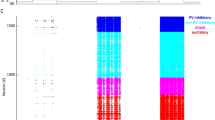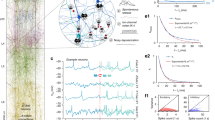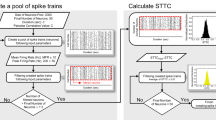Abstract
Detecting the temporal relationship among events in the environment is a fundamental goal of the brain. Following pulses of rhythmic stimuli, neurons of the retina and cortex produce activity that closely approximates the timing of an omitted pulse. This omitted stimulus response (OSR) is generally interpreted as a transient response to rhythmic input and is thought to form a basis of short-term perceptual memories. Despite its ubiquity across species and experimental protocols, the mechanisms underlying OSRs remain poorly understood. In particular, the highly transient nature of OSRs, typically limited to a single cycle after stimulation, cannot be explained by a simple mechanism that would remain locked to the frequency of stimulation. Here, we describe a set of realistic simulations that capture OSRs over a range of stimulation frequencies matching experimental work. The model does not require an explicit mechanism for learning temporal sequences. Instead, it relies on spike timing-dependent plasticity (STDP), a form of synaptic modification that is sensitive to the timing of pre- and post-synaptic action potentials. In the model, the transient nature of OSRs is attributed to the heterogeneous nature of neural properties and connections, creating intricate forms of activity that are continuously changing over time. Combined with STDP, neural heterogeneity enabled OSRs to complex rhythmic patterns as well as OSRs following a delay period. These results link the response of neurons to rhythmic patterns with the capacity of heterogeneous circuits to produce transient and highly flexible forms of neural activity.













Similar content being viewed by others
Explore related subjects
Discover the latest articles and news from researchers in related subjects, suggested using machine learning.References
Abbott, L. F., & Blum, K. I. (1996). Functional significance of long-term potentiation for sequence learning and prediction. Cerebral Cortex, 6(3), 406–416.
Abbott, L. F., & Nelson, S. B. (2000). Synaptic plasticity: taming the beast. Nature Neuroscience, 3(Suppl), 1178–1183.
Abeles, M. (1991). Corticonics: Neural circuits of the cerebral cortex. Cambridge: Cambridge University Press.
Bi, G., & Poo, M. (1999). Distributed synaptic modification in neural networks induced by patterned stimulation. Nature, 401(6755), 792–796.
Bracci, E., Vreugdenhil, M., Hack, S. P., & Jefferys, J. G. (1999). On the synchronizing mechanisms of tetanically induced hippocampal oscillations. The Journal of Neuroscience, 19(18), 8104–8113.
Brunel, N. (2000). Dynamics of sparsely connected networks of excitatory and inhibitory spiking neurons. Journal of Computational Neuroscience, 8(3), 183–208.
Brunel, N., & Hakim, V. (1999). Fast global oscillations in networks of integrate-and-fire neurons with low firing rates. Neural Computation, 11(7), 1621–1671.
Buzsaki, G., Geisler, C., Henze, D. A., & Wang, X. J. (2004). Interneuron diversity series: circuit complexity and axon wiring economy of cortical interneurons. Trends in Neurosciences, 27(4), 186–193.
Collins, J. J., Chow, C. C., & Imhoff, T. T. (1995). Stochastic resonance without tuning. Nature, 376(6537), 236–238.
Demiralp, T., & Basar, E. (1992). Theta rhythmicities following expected visual and auditory targets. International Journal of Psychophysiology, 13(2), 147–160.
Demiralp, T., Basar-Eroglu, C., Rahn, E., & Basar, E. (1994). Event-related theta rhythms in cat hippocampus and prefrontal cortex during an omitted stimulus paradigm. International Journal of Psychophysiology, 18(1), 35–48.
Destexhe, A., & Contreras, D. (2006). Neuronal computations with stochastic network states. Science, 314(5796), 85–90.
Diesmann, M., Gewaltig, M. O., & Aertsen, A. (1999). Stable propagation of synchronous spiking in cortical neural networks. Nature, 402(6761), 529–533.
Eytan, D., & Marom, S. (2006). Dynamics and effective topology underlying synchronization in networks of cortical neurons. The Journal of Neuroscience, 26(33), 8465–8476.
Feldman, D. E. (2000). Timing-based LTP and LTD at vertical inputs to layer II/III pyramidal cells in rat barrel cortex. Neuron, 27(1), 45–56.
Foster, D. J., & Wilson, M. A. (2006). Reverse replay of behavioural sequences in hippocampal place cells during the awake state. Nature, 440(7084), 680–683.
Freund, J. A., Schimansky-Geier, L., & Hanggi, P. (2003). Frequency and phase synchronization in stochastic systems. Chaos, 13, 225–238.
Frey, U., & Morris, R. G. (1997). Synaptic tagging and long-term potentiation. Nature, 385, 533–536.
Friedman, D., Cycowicz, Y. M., & Gaeta, H. (2001). The novelty P3: an event-related brain potential (ERP) sign of the brain’s evaluation of novelty. Neuroscience and Biobehavioral Reviews, 25(4), 355–373.
Fusi, S., & Abbott, L. F. (2007). Limits on the memory storage capacity of bounded synapses. Nature Neuroscience, 10, 485–493.
Ganguli, S., Huh, D., & Sompolinsky, H. (2008). Memory traces in dynamical systems. Proceedings of the National Academy of Sciences of the United States of America, 105(48), 18970–18975.
Gerstner, W., & Kistler, W. (2002). Spiking neuron models: Single neurons, populations, plasticity. Cambridge: Cambridge University Press.
Gerstner, W., Ritz, R., & van Hemmen, J. L. (1993). Why spikes? Hebbian learning and retrieval of time-resolved excitation patterns. Biological Cybernetics, 69(5–6), 503–515.
Gerstner, W., Kempter, R., van Hemmen, J. L., & Wagner, H. (1996). A neuronal learning rule for sub-millisecond temporal coding. Nature, 383(6595), 76–81.
Han, F., Caporale, N., & Dan, Y. (2008). Reverberation of recent visual experience in spontaneous cortical waves. Neuron, 60(2), 321–327.
Hebb, D. O. (1949). The organization of behavior: A neuropsychological theory. New York: Wiley.
Herz, A., Sulzer, B., Kuhn, R., & van Hemmen, J. L. (1989). Hebbian learning reconsidered: representation of static and dynamic objects in associative neural nets. Biological Cybernetics, 60(6), 457–467.
Heynen, A. J., & Bear, M. F. (2001). Long-term potentiation of thalamocortical transmission in the adult visual cortex in vivo. The Journal of Neuroscience, 21(24), 9801–9813.
Izhikevich, E. M. (2006). Polychronization: computation with spikes. Neural Computation, 18(2), 245–282.
Jaaskelainen, I. P., Ahveninen, J., Bonmassar, G., Dale, A. M., Ilmoniemi, R. J., Levanen, S., et al. (2004). Human posterior auditory cortex gates novel sounds to consciousness. Proceedings of the National Academy of Sciences of the United States of America, 101(17), 6809–6814.
Jaeger, H., & Haas, H. (2004). Harnessing nonlinearity: predicting chaotic systems and saving energy in wireless communication. Science, 304(5667), 78–80.
Ji, D., & Wilson, M. A. (2007). Coordinated memory replay in the visual cortex and hippocampus during sleep. Nature Neuroscience, 10(1), 100–107.
Kempter, R., Gerstner, W., & van Hemmen, J. L. (1999). Hebbian learning and spiking neurons. Physical Review E, 59(4), 4498–4514.
Kempter, R., Gerstner, W., & van Hemmen, J. L. (2001). Intrinsic stabilization of output rates by spike-based Hebbian learning. Neural Computation, 13(12), 2709–2741.
Koene, R. A., & Hasselmo, M. E. (2008). Reversed and forward buffering of behavioral spike sequences enables retrospective and prospective retrieval in hippocampal regions CA3 and CA1. Neural Networks, 21(2–3), 276–288.
Levy, N., Horn, D., Meilijson, I., & Ruppin, E. (2001). Distributed synchrony in a cell assembly of spiking neurons. Neural Networks, 14(6–7), 815–824.
Louie, K., & Wilson, M. A. (2001). Temporally structured replay of awake hippocampal ensemble activity during rapid eye movement sleep. Neuron, 29(1), 145–156.
Maass, W., Natschlager, T., & Markram, H. (2002). Real-time computing without stable states: a new framework for neural computation based on perturbations. Neural Computation, 14(11), 2531–2560.
Markram, H., Lubke, J., Frotscher, M., & Sakmann, B. (1997). Regulation of synaptic efficacy by coincidence of postsynaptic APs and EPSPs. Science, 275(5297), 213–215.
Masland, R. H. (2001). Neuronal diversity in the retina. Current Opinion in Neurobiology, 11(4), 431–436.
Masuda, N., & Kori, H. (2007). Formation of feedforward networks and frequency synchrony by spike-timing-dependent plasticity. Journal of Computational Neuroscience, 22, 327–345.
Mehring, C., Hehl, U., Kubo, M., Diesmann, M., & Aertsen, A. (2003). Activity dynamics and propagation of synchronous spiking in locally connected random networks. Biological Cybernetics, 88(5), 395–408.
Mongillo, G., Barak, O., & Tsodyks, M. (2008). Synaptic theory of working memory. Science, 319(5869), 1543–1546.
Morrison, A., Aertsen, A., & Diesmann, M. (2007). Spike-timing-dependent plasticity in balanced random networks. Neural Computation, 19(6), 1437–1467.
Morrison, A., Diesmann, M., & Gerstner, W. (2008). Phenomenological models of synaptic plasticity based on spike timing. Biological Cybernetics, 98(6), 459–478.
O’Connor, D. H., Wittenberg, G. M., & Wang, S. S. (2005). Graded bidirectional synaptic plasticity is composed of switch-like unitary events. Proceedings of the National Academy of Sciences of the United States of America, 102(27), 9679–9684.
Petersen, C. C., Malenka, R. C., Nicoll, R. A., & Hopfield, J. J. (1998). All-or-none potentiation at CA3-CA1 synapses. Proceedings of the National Academy of Sciences of the United States of America, 95, 4732–4737.
Rabinovich, M. I., & Abarbanel, H. D. (1998). The role of chaos in neural systems. Neuroscience, 87(1), 5–14.
Rabinovich, M., Huerta, R., & Laurent, G. (2008). Neuroscience. Transient dynamics for neural processing. Science, 321(5885), 48–50.
Rainer, G., & Miller, E. K. (2002). Timecourse of object-related neural activity in the primate prefrontal cortex during a short-term memory task. The European Journal of Neuroscience, 15(7), 1244–1254.
Ramon, F., & Gronenberg, W. (2005). Electrical potentials indicate stimulus expectancy in the brains of ants and bees. Cellular and Molecular Neurobiology, 25(2), 313–327.
Saigusa, T., Tero, A., Nakagaki, T., & Kuramoto, Y. (2008). Amoebae anticipate periodic events. Physical Review Letters, 100, 018101.
Schwartz, G., Harris, R., Shrom, D., & Berry, M. J., 2nd. (2007). Detection and prediction of periodic patterns by the retina. Nature Neuroscience, 10(5), 552–554.
Shafi, M., Zhou, Y., Quintana, J., Chow, C., Fuster, J., & Bodner, M. (2007). Variability in neuronal activity in primate cortex during working memory tasks. Neuroscience, 146(3), 1082–1108.
Silberberg, G., Bethge, M., Markram, H., Pawelzik, K., & Tsodyks, M. (2004). Dynamics of population rate codes in ensembles of neocortical neurons. Journal of Neurophysiology, 91(2), 704–709.
Sjostrom, P. J., Turrigiano, G. G., & Nelson, S. B. (2001). Rate, timing, and cooperativity jointly determine cortical synaptic plasticity. Neuron, 32, 1149–1164.
Song, S., Sjostrom, P. J., Reigl, M., Nelson, S., & Chklovskii, D. B. (2005). Highly nonrandom features of synaptic connectivity in local cortical circuits. PLoS Biology, 3, e68.
Sumbre, G., Muto, A., Baier, H., & Poo, M. M. (2008). Entrained rhythmic activities of neuronal ensembles as perceptual memory of time interval. Nature, 456(7218), 102–106.
Suri, R. E., & Sejnowski, T. J. (2002). Spike propagation synchronized by temporally asymmetric Hebbian learning. Biological Cybernetics, 87(5–6), 440–445.
Swadlow, H. A. (1985). Physiological properties of individual cerebral axons studied in vivo for as long as one year. Journal of Neurophysiology, 54(5), 1346–1362.
Thivierge, J. P., & Cisek, P. (2008). Nonperiodic synchronization in heterogeneous networks of spiking neurons. The Journal of Neuroscience, 28(32), 7968–7978.
Thivierge, J. P., Rivest, F., & Monchi, O. (2007). Spiking neurons, dopamine, and plasticity: timing is everything, but concentration also matters. Synapse, 61(6), 375–390.
Thomson, A. M., & Lamy, C. (2007). Functional maps of neocortical local circuitry. Frontiers in Neuroscience, 1, 19–42.
van Rossum, M. C., Turrigiano, G. G., & Nelson, S. B. (2002). Fast propagation of firing rates through layered networks of noisy neurons. The Journal of Neuroscience, 22(5), 1956–1966.
van Vreeswijk, C., & Sompolinsky, H. (1996). Chaos in neuronal networks with balanced excitatory and inhibitory activity. Science, 274(5293), 1724–1726.
Vogels, T. P., & Abbott, L. F. (2005). Signal propagation and logic gating in networks of integrate-and-fire neurons. The Journal of Neuroscience, 25(46), 10786–10795.
Vogels, T. P., Rajan, K., & Abbott, L. F. (2005). Neural network dynamics. Annual Review of Neuroscience, 28, 357–376.
Wang, Y., Markram, H., Goodman, P. H., Berger, T. K., Ma, J., & Goldman-Rakic, P. S. (2006). Heterogeneity in the pyramidal network of the medial prefrontal cortex. Nature Neuroscience, 9, 534–542.
Yao, H., Shi, L., Han, F., Gao, H., & Dan, Y. (2007). Rapid learning in cortical coding of visual scenes. Nature Neuroscience, 10(6), 772–778.
Zhang, L. I., Tao, H. W., Holt, C. E., Harris, W. A., & Poo, M. (1998). A critical window for cooperation and competition among developing retinotectal synapses. Nature, 395(6697), 37–44.
Acknowledgments
JPT is supported by postdoctoral fellowships from the Natural Sciences and Engineering Research Council of Canada and the Fonds de Recherche en Santé du Québec. PC is supported by grants from the Natural Sciences and Engineering Research Council of Canada and the Fonds de Recherche en Santé du Québec (infrastructure grant).
Author information
Authors and Affiliations
Corresponding author
Additional information
Action Editor: X.-J. Wang
Electronic Supplementary Material
Below is the link to the electronic supplementary material.
ESM 1
(RAR 8 kb)
Rights and permissions
About this article
Cite this article
Thivierge, JP., Cisek, P. Spiking neurons that keep the rhythm. J Comput Neurosci 30, 589–605 (2011). https://doi.org/10.1007/s10827-010-0280-1
Received:
Revised:
Accepted:
Published:
Issue Date:
DOI: https://doi.org/10.1007/s10827-010-0280-1




